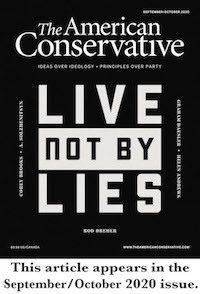We Need a New Fusionism

Editor’s Note: This piece was written as a response to our “What is American Conservatism?” cover story symposium from our July/August issue of TAC.
Conservatism is almost as divided as America, split between divergent brands that range from traditional and social conservatism to libertarian and constitutional conservatism. But there is no reason to despair—conservatives have never marched in lockstep. Just as they oppose centralized economic planning, so do they oppose centralized political planning. The conservative movement is a loosely bound movement made up of, in Morton Blackwell’s words, “activists, scholars, donors, and organizational entrepreneurs held together by … shared philosophy, shared enemies, and shared experiences.”
And it is a movement that comes together when confronted with a common foe. Such was the case in the 1960s when National Review editor Frank Meyer proposed a synthesis of the traditionalist and libertarian strains of conservatism that came to be called “fusionism.”
The core principle of fusionism is that “the freedom of the person [is] the central and primary end of political society.” To Meyer, man was a rational autonomous individual, and freedom was the essence of his being, indispensable to his pursuit of happiness. Yet Meyer also insisted that modern American conservatism was not classical liberalism, which had been weakened by utilitarianism and secularism. Conservatives sought to save the Christian understanding of “the nature and destiny of man.” Meyer insisted he was not creating anything new, but articulating an already existing conservative consensus—“the consensus forged so brilliantly by the Founding Fathers” with the U.S. Constitution. The clear danger that existed and united traditionalists and libertarians then and through the 1980s was the Soviet Union and its vow to communize the world.
Which brings us to the last issue of The American Conservative that asks, “What Is American Conservatism?” in the Trump era. It provides answers from 20-some representatives of the New Right, the Old Right, and the Just Right.
While a couple of contributors dismiss conservatism as a collection of “bizarre little cults” that are “no longer capable of anything but reflexive spasms” and declare that “American conservatism…is a failure,” the majority prefer to concentrate on how to rejuvenate conservatism. Their proposals constitute a consensus that now is the time for the forging of a New Fusionism.
Although he does not use the word, the American Enterprise Institute scholar Yuval Levin opens the door into the world of fusionism. He concedes that the market economy is critical to a free society but insists that it is “dangerously inadequate” as a means to the end of a common good. Ultimately, Levin says, the present passionate debates between conservatives are about “how best to apply a complex view of the human person to the politics of a free nation.”
Daniel McCarthy, editor of the traditionalist journal Modern Age, writes that in the present age of ideological revolution, conservatism is “a counter-revolutionary force which, despite its flaws, is worthy of our loyalty.” American conservatives, he says, must make a deep commitment to the sources of our civilization “if we are to prevail again,” as we did following the French Revolution and during the Cold War.
The editor of the Liberty Fund’s Law & Liberty, Richard Reinsch, issues a clarion call for “Constitutional Conservatism.” In response to the threats to our very existence, he writes, “we must conserve this American nation with its constitutional form of government and commitment to ordered liberty.”
Neal Freeman, who worked with Frank Meyer on the 1964 volume What Is Conservatism?, insists that fusionism is “the best mechanism ever devised for the diffusion of conservative ideas.” He sets forth two things that must be done to achieve an effective New Fusionism. One, solidify the conservative base by reaching out to social (pro-life) conservatives who have been “model partners.” Two, reestablish the relationship with libertarian conservatives, an essential part of the old fusionism. Freeman says conservatism needs the libertarians and their commitment to individual freedom because of “the dynamics of ideological debate” and “the mathematics of electoral politics.”
Here are some of the lessons to be gleaned from TAC’s laudable colloquium.
One, American conservatism is not dead, as Bill Buckley biographer Sam Tanenhaus once proclaimed, but is very much alive and the object of constant examination, proof of its ability to impact the body politic.
Two, American conservatism is at its best when it practices fusionism. The historic successes of the Reagan years, including the implementation of supply-side economics and ending the Cold War at the bargaining table and not on the battlefield, proved that. Today’s trifecta of crises—the coronavirus pandemic, the struggling economy, and the challenge of persistent racism—calls for a New Fusionism encompassing the major strains of conservatism.
implementation of supply-side economics and ending the Cold War at the bargaining table and not on the battlefield, proved that. Today’s trifecta of crises—the coronavirus pandemic, the struggling economy, and the challenge of persistent racism—calls for a New Fusionism encompassing the major strains of conservatism.
Three, American conservatism is just that—American, not European, confident and optimistic, reliant on the founding truths of the Republic and on Western civilization.
What should conservatives do in this testing time? Be radical in thought and action. Educate the Millennials about the myths and realities of socialism. Sponsor a series of Great Debates on topics like “Is the Safety Net Really Safe?” Publish a National Conservative Platform as the takeaway from a National Conservative Convention. Take the lead in demonstrating that the American Spirit still lives, America remains an exceptional nation, and “We the People” still govern. All this can best be done through a New Fusionism that unites conservatives of all persuasions in a crusade to preserve that most precious of our possessions—ordered liberty.
Lee Edwards is a distinguished fellow in conservative thought in the Simon Center at the Heritage Foundation.
Comments